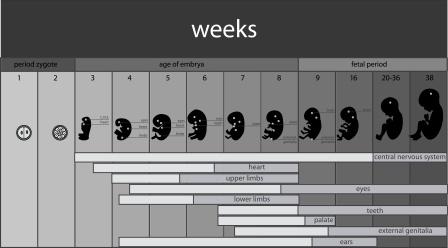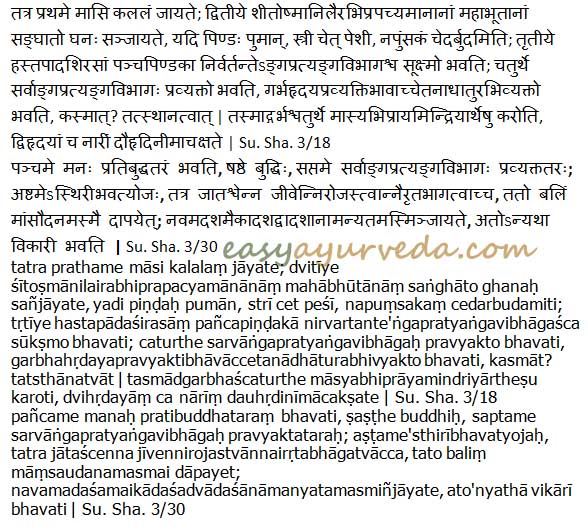Monthly Development Of Fetus – masanumasika garbha vriddhi
Article by Dr Raghuram Y.S. MD (Ay) and Dr Manasa, BAMS|
Table of Contents
Introduction
We all come into this world following a beautiful chemistry between 2 cells, a sperm (male cell or gamete) and ovum (female cell or gamete). The product of the union of sperm and ovum is called zygote. The zygote later gets the form of an embryo. An embryo is an unborn offspring in the process of development.
Later the cell division progresses towards clear differentiation and manifestation of body parts and organs. At this stage it will be called fetus (prenatal human between the embryonic state and birth). The process of this development of fetus takes place in a slow and steady phase and gets completed in around 9 months. By this time the fetus gets matured and fully formed. The fetus will be said to have reached its term and would be ready to be born.

The formation of zygote and embryo and subsequent development of the embryo into fetus in various stages of development and maturity over a period of 9 months is called Garbha in Ayurveda.
Read related: Conception And Formation Of Fetus As Per Ayurveda
The whole process is called Garbha utpatti or Garbhavakranti (development and maturity of fetus).
This constitutes the basics of the earliest embryology known to the mankind i.e. ‘Ayuvedic Embryology’ or ‘Garbha Sharira’.
In this article I would like to touch upon the ‘Masanumasika Garbha Vriddhi Krama’ or the month wise development of fetus from an Ayurvedic perspective.
Read related: Essential Elements For Conception – Garbha Sambhava Samagri
Masanumasika Garbha Vriddhi
Ayurvedic texts have clearly explained the process of monthly development of fetus in detail. The explanation is unique and may not exactly correlate with the explanation given in modern embryology.

Masa-Anumasika Garbha Vriddhi Krama
1st month
1st month – Formation of cell mass
After the sexual intercourse, the sperm fertilizes the ovum. In the first month (of pregnancy), following fertilization and implantation of the embryo in the uterine cavity, only kalala or ‘mass of cells’ is formed. This is explained by the commentators as ‘singhanaka’ i.e. phlegm like substance stained with streaks of blood.
2nd month
2nd month – Formation of compact mass, determination of sex of the child
In the second month, the embryo under the influence of sheeta (kapha), ushna (pitta) and anila (Vayu) and its bhutas (the involvement of 5 elements of nature i.e. Prithvi or earth, Jala or water, Teja or fire, Vayu or air and Akasha or ether / space) forms into a compact mass (Ghana sanghata).
The sex of the child (fetus) is also determined in the second month of pregnancy itself. This is determined depending on the shape of the compact mass (Ghana sanghata) formed in the 2nd month.
If the Ghana sanghata is in the form (shape) of a pinda (bolus), it would be a male (pumaan) child.
If the Ghana sanghata is in the form (shape) of a peshi (quadrangular like a striped muscle) it would be a female (stree) child.
If the Ghana sanghata is in the form of (shape) an arbuda (bubble, hemi-spherical), it would be an eunach (napumsaka).
3rd month
3rd month – Formation of buds (ossification centres) for limbs and head
In the 3rd month of pregnancy, five buds or ossification centres representing the formation of 4 limbs (2 upper limbs and 2 lower limbs) and head respectively are formed. The anga-pratyangas (organs and their structures) also start forming indistinctly i.e. there is unclear manifestation of organs and their structures in this month.
Note – Angas means Shadangas or 6 organs i.e. 2 upper limbs, 2 lower limbs, trunk (middle portion of the body including chest and tummy) and head. Pratyangas means the sub organs located in these angas i.e. neck, eyes etc.
4th month
4th month – Distinct formation of organs, manifestation of heart, life element, fetal movements
In the fourth month of pregnancy, the anga pratyangas (organs and their structures) are distinctly developed. While in the 3rd month the organs have started to manifest indistinctively, they would have completely formed by the 4th month. The fetal circulation is established. With this, the circulation of nutrients gets clearly established between the mother and child. The embryo or garbha develops mind and mental faculties. As a result, the mother starts feeling the movements of the embryo. Such feeling of fetal movements is known as quickening. At this stage of quickening, the mother develops some unusual desires, which probably indicate the desires of the growing fetus. The wishes of the child are manifested through mother. The woman at this stage is said to have 2 hearts, one of hers and the other of the fetus. From this month, the mother will be called as ‘Dauhridini’ or the ‘one with 2 hearts’. It is said that all the desires of the woman arising in this period shall not be taken lightly since they are the demands of the child. They compensate the needs of the child. Therefore these wishes should be fulfilled.
If the wishes of Dauhridini are not fulfilled, the child will be born with defects and deformities like kubja (dwarf), kuni (short upper limbs), khanja (limp), vamana (short), vikrutaksha (deformed eyes), anaksha (blind) etc. On the contrary, if the wishes of dauhridini are fulfilled she will give birth to a child who will be strong and would live a long span of life.
5th month
5th month – Progressive development of mind
In the 5th month of pregnancy, the mind develops further
6th month
6th month – Development of intellect
In the 6th month of pregnancy, the development of buddhi or intellect is seen
7th month
7th month – Complete development of fetal body parts
In the 7th month of pregnancy, the fetal body parts are completely developed. All the anga pratyangas are said to be completely developed.
8th month
8th month – Instability of life
In the 8th month of pregnancy the ojas or essence of all the tissues in the body (which determine the immunity of the child) gets disturbed and is instable. It is said that the life will be instable in this month. It is also said that the child born in this month may not survive.
9th month
9th month – Complete development of fetus, delivery, birth of child
The complete development of the fetus and delivery of the child may take place at the end of 9th month. It is said that this process of complete development of fetus and child birth may take place between 9th and 12th month of pregnancy.
Just before finishing –
Ayurveda has explained embryology comprehensively, in its own style. The view-point may look little different when compared to the modern day embryology, but structurally and basically the theory of development of child in the mother’s womb as explained in Ayurveda is exemplary, especially when seen that these details were documented in a period when the technologies of modern science were not existing.
Click to Consult Dr Raghuram Y.S. MD (Ayu)









3 comments
Murli Nayar
That was really informative
Ramya
According to Ayurveda foetal heart and circulation starts in 4th month. But according to allopathy heartbeat must be seen by 6 – 7 th week with transvaginal ultrasound. Because of no heartbeat in my 8 weeks pregnancy doctors diagnosed me with missed abortion. So i went on with medical termination of pregnancy. Did i made a mistake by not waiting for the heartbeat to start….. Please answer me.
Dr J V Hebbar MD(Ayu)Author
No. You did not make a mistake. The Ayurvedic explanation refers to almost fully grown heart. However, heart should be formed by 6th or 7th week, though not fully functional.